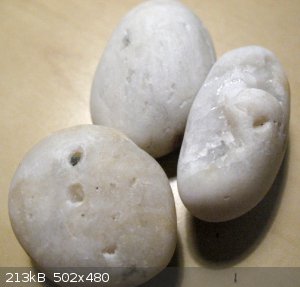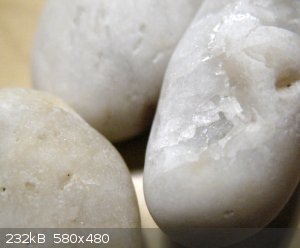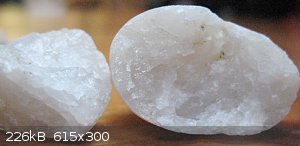CHRIS25
National Hazard
   
Posts: 951
Registered: 6-4-2012
Location: Ireland
Member Is Offline
Mood: No Mood
|
|
Quartz Pebbles
Not being familiar at all with Geology I wanted to identify these pebbles, after some searching I presume that they are simply Quartz pebbles, and
they have quite a lot of quartz crystals on the surface and in the holes, and I wondered if this also is simply silicon dioxide. I have never seen so
many of these in one place on a certain beach and it got me curious to be asking whether there is any realistically sensible chemistry I can do with
this sort of stone? And since there are so many different types of quartz stones does anyone recognize any particular chemical composition that might
be here, apart from the usual silicon dioxide?
 
‘Calcination… is such a Separation of Bodies by Fire, as makes ‘em easily reducible into Powder; and for that reason ‘tis call’d by some
Chymical Pulverization.’ (John Friend, Chymical Lectures London, 1712)
Right is right, even if everyone is against it, and wrong is wrong, even if everyone is for it. (William Penn 1644-1718)
The very nature of Random, Chance development precludes the existence of Order - strange that our organic and inorganic world is so well defined by
precision and law. (me)
|
|
|
blargish
Hazard to Others
  
Posts: 166
Registered: 25-9-2013
Location: Canada
Member Is Offline
Mood: Mode Push
|
|
It's kinda difficult to determine the nature and composition of a rock/mineral solely based on appearance. To make sure that what you have is quartz
you should probably do a few different tests (if you haven't already). Does it show any effervescence with acid? Does a pocket knife scratch it? The
mohs hardness test is usually a great way to get a good idea of the nature of a mineral/rock.
As for the chemistry, I'm not too familiar with what you would be able to do with it, other than grinding it up and using it in the usual applications
of SiO2 (boiling chips, silicon thermite, idk)
The fact that the pebbles are white (assuming it is quartz/quartzite) makes it probable that it is merely just SiO2 with no other
particular chemical composition. From what I know, different colors (especially in quartz) reflect differences in trace chemical composition: ie. the
pink color of rose quartz is usually due to trace titanium or manganese in the structure.
BLaRgISH
|
|
|
Amos
International Hazard
    
Posts: 1406
Registered: 25-3-2014
Location: Yes
Member Is Offline
Mood: No
|
|
You can break them up with a hammer or large rock and use them as boiling chips, after cleaning them with an acid of fair strength, of course.
|
|
|
phlogiston
International Hazard
    
Posts: 1376
Registered: 26-4-2008
Location: Neon Thorium Erbium Lanthanum Neodymium Sulphur
Member Is Offline
Mood: pyrophoric
|
|
These do look like common quartz pebbles, but as largish already said it is hard to tell from an image alone.
From an amateur chemistry perspective, quartz is a little boring. You could extract silicon from it. Or make magnesium silicide and subsequently use
that to make silane, which is often done as a nice demonstration experiment. But this could be done with any reasonably pure
SiO<sub>2</sub> sand.
Noting your location, Ireland has lots of interesting minerals and it might be a nice project to find some more chemically interesting/unique rocks to
play with.
I envy you; I love to collect minerals myself, and my country (the Netherlands) is pretty boring in that respect.
[Edited on 31-12-2014 by phlogiston]
-----
"If a rocket goes up, who cares where it comes down, that's not my concern said Wernher von Braun" - Tom Lehrer |
|
|
diddi
National Hazard
   
Posts: 723
Registered: 23-9-2014
Location: Victoria, Australia
Member Is Offline
Mood: Fluorescent
|
|
they are certainly just quartz. which is SiO2. that said, I would not use them for any chemical exploits (even as boiling chips) because do you
notice the feint orange tinge? this is caused by Fe3+ in the matrix. it is by far the most common impurity in quartz. it is NOT surface dirt.
the crystals are interesting. good ones a clear and have a hexagonal pyramid at the end.
|
|
|
CHRIS25
National Hazard
   
Posts: 951
Registered: 6-4-2012
Location: Ireland
Member Is Offline
Mood: No Mood
|
|
Ah such a shame then. There are so many different types of rocks here to see, every single beech, often only 5 Km apart will have totally different
stones and rock formations. I often come across spectacular stones and crystals embedded and simply just admired them, until that is I started
getting into chemistry a few years ago, so now I am interested just to see what could be done from a chemistry point of view. Some are pure white in
the above structure, but others have orange and lemon and brown veins in them. So no boiling chips then. Will break them up, look up mohrs hardness
table and see what is what.
Thanks for the input gentlemen.
‘Calcination… is such a Separation of Bodies by Fire, as makes ‘em easily reducible into Powder; and for that reason ‘tis call’d by some
Chymical Pulverization.’ (John Friend, Chymical Lectures London, 1712)
Right is right, even if everyone is against it, and wrong is wrong, even if everyone is for it. (William Penn 1644-1718)
The very nature of Random, Chance development precludes the existence of Order - strange that our organic and inorganic world is so well defined by
precision and law. (me)
|
|
|
diddi
National Hazard
   
Posts: 723
Registered: 23-9-2014
Location: Victoria, Australia
Member Is Offline
Mood: Fluorescent
|
|
quartz is 7. it polishes well if you are into faceting or making jewellery, but you will find those pebbles will have a lot of flaws and cracks.
could be good for your garden track or throwing at noisy dogs in the night. they are the same family as amethyst, citrine, rock crystal etc
if you want to know what rocks are in your area, visit mindat.org
[Edited on 31-12-2014 by diddi]
|
|
|
blogfast25
International Hazard
    
Posts: 10562
Registered: 3-2-2008
Location: Neverland
Member Is Offline
Mood: No Mood
|
|
They look like quartz pebbles. You can run one test that at least excludes limestone: put a drop of strong HCl on them.
To identify them as mainly SiO<sub>2</sub> strong HF would normally be used. Alternatively crush and fuse the powder with molten NaOH or
KOH in a nickel crucible. It forms silicates if it's quartz. Leaching with water and neutralisation of the lixiviate with HCl then causes silica gel
to precipitate. But in theory the material could still be an alumino silicate (of which there is an abundance in the petrosphere), because that would
give the same result.
If the pebbles look as if they contain no air pockets, a density reading will also be insightful.
[Edited on 31-12-2014 by blogfast25]
|
|
|
CHRIS25
National Hazard
   
Posts: 951
Registered: 6-4-2012
Location: Ireland
Member Is Offline
Mood: No Mood
|
|
Well as for hardness, there were no visible scratch marks after scraping with iron or titanium metal (this happens to be a 1/3 kilogram jagged raw
piece that is VERY hard indeed). I broke one open and here are the insides, full of crystals. I don't have a nickel crucible, why nickel asks mr.
ignorant. Stainless steel resists KOH and NaOH. Then transfer to Glass for the HCl? Anyway, I like the idea of that piece of chemistry so far.

[Edited on 31-12-2014 by CHRIS25]
‘Calcination… is such a Separation of Bodies by Fire, as makes ‘em easily reducible into Powder; and for that reason ‘tis call’d by some
Chymical Pulverization.’ (John Friend, Chymical Lectures London, 1712)
Right is right, even if everyone is against it, and wrong is wrong, even if everyone is for it. (William Penn 1644-1718)
The very nature of Random, Chance development precludes the existence of Order - strange that our organic and inorganic world is so well defined by
precision and law. (me)
|
|
|
blogfast25
International Hazard
    
Posts: 10562
Registered: 3-2-2008
Location: Neverland
Member Is Offline
Mood: No Mood
|
|
Chris, nickel because of it's high resistance to molten alkali. But steel is fairly good too. You will get SOME iron pick up though: your
silicate/alkali mixture will be a bit reddish from Fe(OH)3. Use about 2 times the weight of NaOH/KOH per quartz. Fuse for about 20 minutes on medium
heat.
After fusing, allow to cool, then cover the crucible content with water for a bit to loosen things up. Put the crucible on a low setting hot plate for
a bit, then carefully (gloves and goggles or glasses!) prise the contents out of the crucible and into a glass beaker. Add a little water: most of it
should dissolve easily with a bit of simmering (but not the Fe(OH)3, of course). Then filter.
Dilute the filtrate a bit more (say 1 V filtrate/1 V water), then slowly add strong HCl or 30 % H2SO4. A colourless gelatinous precipitate points to
SiO2 and thus quartz or an alumino silicate.
For density of a whole pebble, try this method:
http://oxfordchemserve.com/density-of-solid-objects-archimed...
[Edited on 31-12-2014 by blogfast25]
|
|
|
CHRIS25
National Hazard
   
Posts: 951
Registered: 6-4-2012
Location: Ireland
Member Is Offline
Mood: No Mood
|
|
Greatly appreciated, will get onto this in the coming days. And thanks for the density link.
‘Calcination… is such a Separation of Bodies by Fire, as makes ‘em easily reducible into Powder; and for that reason ‘tis call’d by some
Chymical Pulverization.’ (John Friend, Chymical Lectures London, 1712)
Right is right, even if everyone is against it, and wrong is wrong, even if everyone is for it. (William Penn 1644-1718)
The very nature of Random, Chance development precludes the existence of Order - strange that our organic and inorganic world is so well defined by
precision and law. (me)
|
|
|
blargish
Hazard to Others
  
Posts: 166
Registered: 25-9-2013
Location: Canada
Member Is Offline
Mood: Mode Push
|
|
In addition, the fracture/cleavage of the pebble when breaking it apart is a great indicator of mineral type as well. Quartz displays a "conchoidal"
fracture and has no planes of cleavage. This means that it doesn't break along any defined planes and tends to form these curvy, scoop like fractures
(the same fracture if you were to take a chip out of a pane of glass). From what I can see in the picture, this seems to be the case, so my guess is
that what you have is indeed quartz.
However, the chemistry approach to determine it's composition seems much more interesting
BLaRgISH
|
|
|
blogfast25
International Hazard
    
Posts: 10562
Registered: 3-2-2008
Location: Neverland
Member Is Offline
Mood: No Mood
|
|
Aluminium can also be detected in silicate based minerals as follows.
Boil the slurry containing the silica gel in to dryness. Add concentrated H2SO4 and keep hot while stirring for 1/2 hour. Allow to cool. Then
carefully add about 5 volumes of cold water, bit by bit while stirring. Any aluminium will have been leached out, the silica is not.
Cool and filter off the insolubles. The filtrate will contain the aluminium as sulphate. Alkalise with strong ammonia to pH approx. 10. Aluminium, if
present, will show as a white gelatinous precipitate of Al(OH)3.
[Edited on 1-1-2015 by blogfast25]
|
|
|